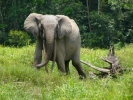 As world leaders and conservationists descended on London last week for the Illegal Wildlife Trafficking Conference, the burning question in their minds was: How can trade in ivory, especially in Asian countries be contained? The fear is that Africa’s elephants could go the way of dinosaurs. Some 20,000 jumbos are killed each year — 55 every single day — mostly for the illegal ivory trade.
As world leaders and conservationists descended on London last week for the Illegal Wildlife Trafficking Conference, the burning question in their minds was: How can trade in ivory, especially in Asian countries be contained? The fear is that Africa’s elephants could go the way of dinosaurs. Some 20,000 jumbos are killed each year — 55 every single day — mostly for the illegal ivory trade.
The war on the illicit trade was dealt a blow on February 4, when ivory researcher Esmond Martin, who had authored several investigative reports on rhino and ivory smuggling in Kenya and the trade in China, Vietnam, and Laos, was found murdered in his Karen home in Nairobi.
Data from World Wide Fund for Nature shows that African elephants numbered three to five million in the last century. However, WWF says, their populations were severely reduced to its current levels because of hunting. In the 1980s, WWF estimates that 100,000 elephants were killed each year, and up to 80 per cent of herds were lost in some regions. In recent years, growing demand for ivory, particularly from Asia, has led to a surge in poaching.
Elephant populations — especially in southern and eastern Africa, which once showed promising signs of recovery — could be at risk due to the recent surge in poaching for the illegal ivory trade. Habitat loss and fragmentation and human-elephant conflict have also been blamed for the decline by WWF.


